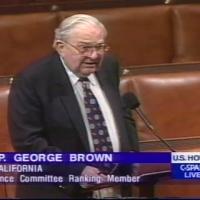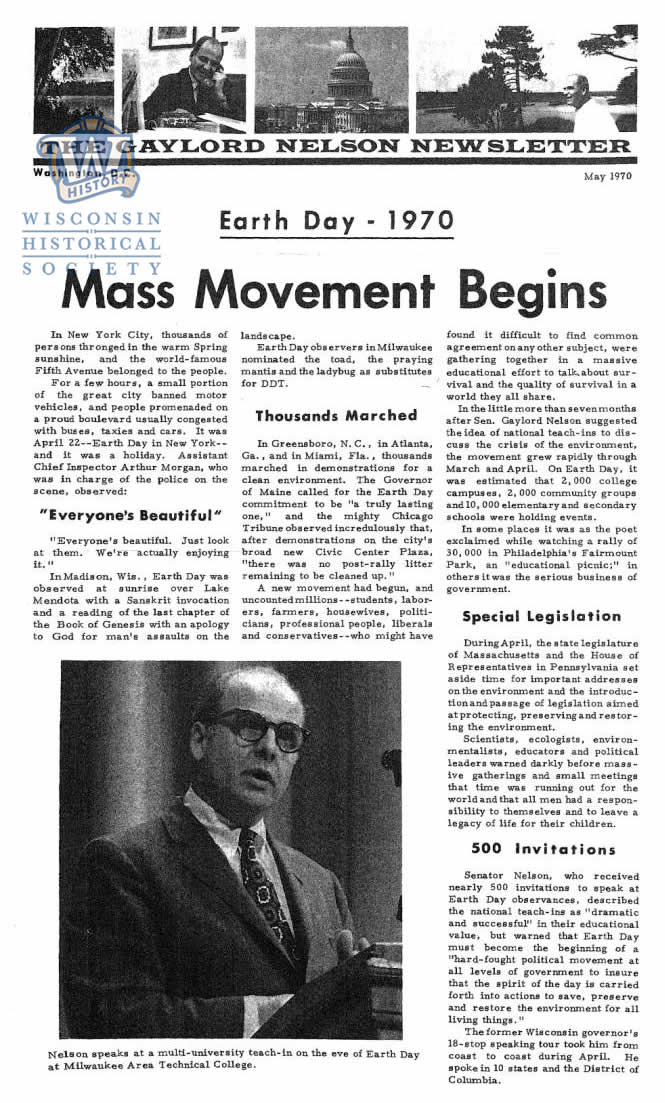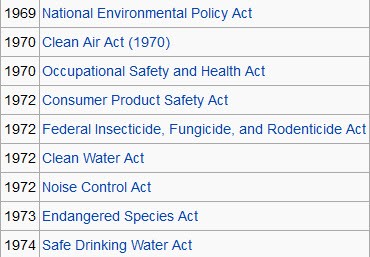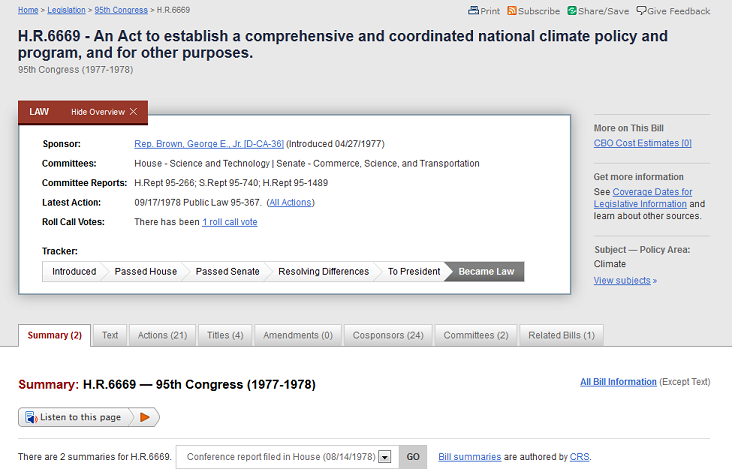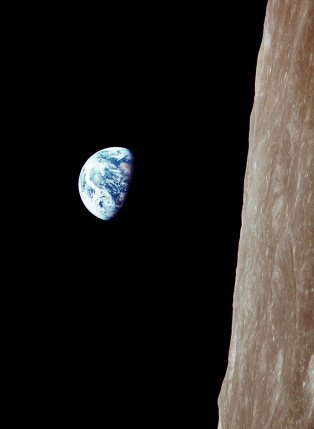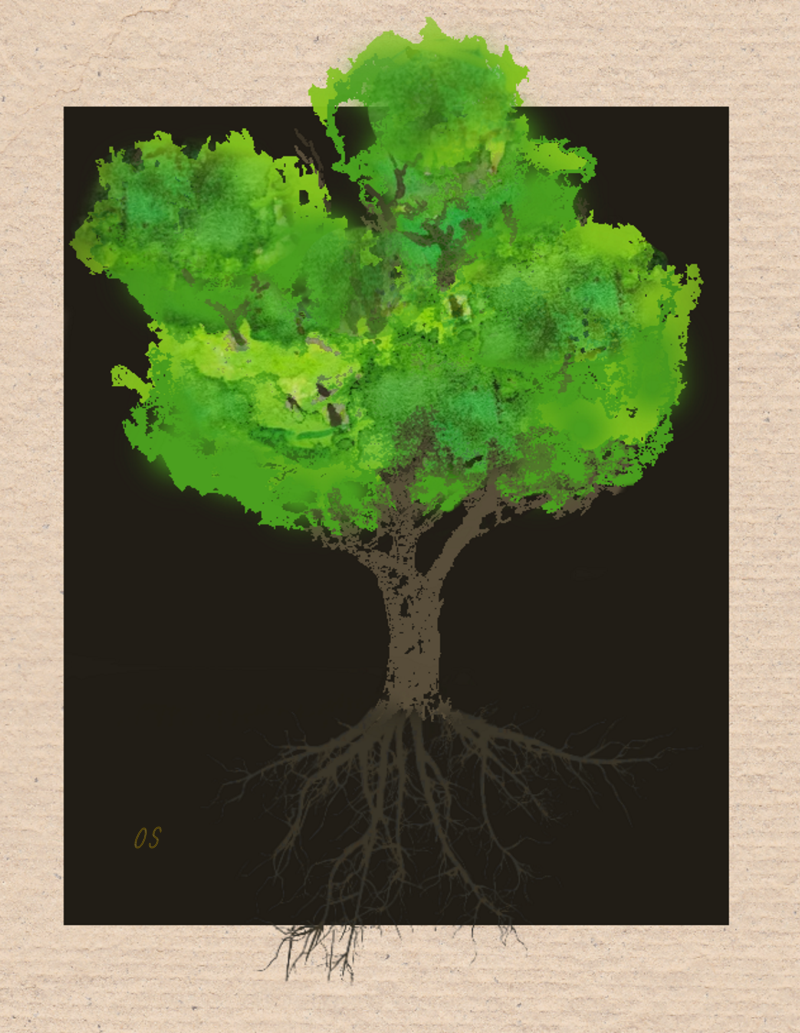Earth Day Memories on the 50th Anniversary: Difference between revisions
Siterunner (talk | contribs) No edit summary |
Siterunner (talk | contribs) No edit summary |
||
| Line 223: | Line 223: | ||
We are on a [http://planetcitizen.org planet citizen voyage], we are all [http://planetcitizens.org planet citizens]. Welcome onboard ! | We are on a [http://planetcitizen.org planet citizen voyage], we are all [http://planetcitizens.org planet citizens]. Welcome onboard ! | ||
Memories of the first Earth Day, April 22, 2020, go | Memories of the first Earth Day, April 22, 2020, go on and we keep on keeping on... | ||
Revision as of 22:38, 23 April 2020
Earth Day 2020 50th Anniversary of first Earth Day "Teach-In" / April 22, 1970
Art by Olivia Schmidt / BY-NC Creative Commons / Use w/ Attribution + Non-commercial
On the 50th Anniversary
Memories on the Road to the First Earth Day
Steven Schmidt / GreenPolicy360 Siterunner
It started on a Schwinn bike in the mid-1960s. My road to April 22, 1970. The day that would be called the first "Earth Day" began with a response by George E. Brown our newly elected local Congressman to my simple query -- help.
• https://www.greenpolicy360.net/w/George_E._Brown_Jr
I asked George, a plump fellow with a big smile, to help me as a high school debate student arguing about the risks of nuclear war and 'nth country proliferation'. A long friendship began as I attempted to sort out the school year's debate topic -- nuclear weapons and war.
Our era was the height of the Cold War and it had suddenly gotten hot with a near catastrophe of US-Russia nuclear missile launches during the Cuban US-Russia Crisis. I wanted to better understand the international problems that could end in nuclear disaster. I figured a Congressman could at least point me in the right direction.
My perspective as a kid from East Los Angeles was limited but I knew enough to know that 1962, one year before Brown was elected, came close to delivering that hot flash in the sky.
Schools practiced the Duck and Cover and those sirens became real. The possibility of death by nuclear weapons was not far off. I know this both viscerally and intellectually. My thought in contacting the Congressman was that I could get a debate team advantage by knowing the details of nuclear weapons and I knew Congressman Brown was in the news talking about them.
I didn't know that day that the man who was about to become a thirty year + friend, and mentor to me, was also a hard negotiator. He told me he'd help me with nuclear issues for my debating, if I would drive around on my bike in neighborhoods during his re-election campaigns and put up signs (and take down signs.) I eagerly agreed.
Rep. Brown would go on to head up the science and technology committee in the House of Representatives, become instrumental in the creation of the EPA, the approval of the Clean Air Act, overseeing federal 'Big Science' initiatives, moving foward a first generation of NASA earth science missions, including LANDSAT and beginning the data baselines of new earth system science.
George, as I came to call him, would draft the first National Climate Act in 1978 and shepherd its passage. He also was, at times, a controversial 'peacenik', he opposed the Vietnam War's policies. He was opposed to the nuclear weapons arms race.
That day he and I first met was at the beginning, before his decades long career and before I shared many moments and worked together over the years as both of our work ran on parallel paths.
But let me go back to the Schwinn and another memory.
The X-ray George showed me in his office. It left a strong imprint on my consciousness as a kid growing up in the worst years of LA smog. I had asthma as did many kids and the X-ray was of a kid's lungs, after death. The impairment, the darkness, was evident and George carried on that day, the trained engineer that he was, talking about how 'we' needed to clean the air up, to make LA a model, California a model of what could happen if the people protected the kids. I don't remember all the details of his plan, but I remember the X-ray.
The Congressman was a man of action and I have to say his words led to deeds. He made plans, I learned over the years, engineer's plan, and he pursued them with his rumpled suits and pipe smoking and his twinkling eye. He also knew politics and could persuade, as he did, politicos right and left.
So let's talk the biggest politico of the Republican Party, Richard M. Nixon from Whittier, a nearby town and a man that George Brown knew he had to work with if he was going to get his agenda accomplished.
Up Top, Clean Air
Nixon would be elected in 1968 on a promise to end the Vietnam War. The political world was in upheaval with assassinations of Martin Luther King and Robert Kennedy. Riots had broken out. The 68 Democratic convention in Chicago was a violent riot in itself and Nixon hoped to take advantage of the politics of the day, even as he clamped down on a strongly growing peace movement.
This is where I come back into the story of the first Earth Day.
I had gone off to USC in downtown LA, had become a student activist and met Rep. Allard Lowenstein D-NY, during one of my meetings. He asked me to fly to Washington and help organize a new anti-war group called the Vietnam Moratorium Committee. I met the other organizers, Sam Brown, Dave Hawk, David Mixner, Marge Sklenkar and Congressman Lowenstein hovered in the background. I signed up.
• https://en.wikipedia.org/wiki/Moratorium_to_End_the_War_in_Vietnam
My world dramatically changed as I returned to USC. It was time to pivot from a simpler life. I turned down my acceptance to Berkeley and decided USC would be the epicenter in California for the Moratorium. We'd be telling Berkeley students what to do, just the thought of our historically far-right campus changing stripes and going into the Free Speech Bay area to coordinate the statewide peace movement was enough motivation for me to go full out.
We arranged to take over most of the SC Religious Center building offices to coordinate Moratorium teach-ins, strikes, organizing. Congressman Brown was of great assistance and the first state-wide protest on October 15, 1969 became a huge event. At USC, we put together a peace day in Exposition Park, a crowd of thousands. I spoke, Rev. Ralph Abernathy spoke, Paul Schrade, the union leader who was shot when Bobby Kennedy was killed by Sirhan Sirhan spoke, Harold Willens of Business Executives for Peace added the business community's voice -- marches went to City Hall, all together it was a public statement that was historic, the largest anti-war group, the Moratorium committee across the nation sent a message to President Nixon.
What we didn't know but would find out later was how close the nation and world came to commencing a nuclear conflict in 1969.
Let's pause here -- it is more than important to slow down here and talk about another nuclear weapons close call. The reporting on this came from the National Security Council years later. Mort Halperin, Roger Morris, Dan Ellsberg would write about it.
Nixon almost took the Vietnam war nuclear in November 1969
Here, take a look at this passage from Dan Ellsberg's book, Doomsday Machine: Confessions of a Nuclear War Planner from our GreenPolicy360 associate --
"There was pressure to make the war larger" and "nuclear targets were picked" by the Nixon administration, the Pentagon Papers whistleblower revealed.
• https://www.strategicdemands.com/doomsday-machine/
• https://www.amazon.com/Doomsday-Machine-Confessions-Nuclear-Planner-ebook/dp/B074HZMN71/
Richard Nixon and Henry Kissinger had a plan to end the war in Vietnam by escalating and going even beyond B-29 bombings with greater magnitude than the bombing tonnage of WWII. The nuclear war plans were drawn and ready to go -- what stopped it?
The October 1969 nationwide Moratorium...
I had become a friend of Dan Ellsberg as he went through his now well known preparations and release of the "Pentagon Papers".
As a leader of the anti-war efforts, I listened to Dan's revelations that found their way into my speeches, work, travels. The lies of the leaders of the country became top of mind when the facts of the war were revealed. That the president was close to dropping nuclear weapons to further escalate was not known to me at that time, but certainly our strategy of the Vietnam Moratorium Committee was to demonstrate to the President and country that mainstream American opposed the carnage and the failed policy of inserting the US into a civil war between North and South Vietnam.
The Moratorium teach-ins were planned as a series of peace demonstrations into the spring of 1970 -- we knew the protests had to have a positive message too. That message became more teach-ins and the 1969 organizing led to 1970 teach-ins and, fortunately, the positive messages of the first Earth Day in April of 1970.
An astonishing success, the first Earth Day in 1970 was celebrated by some 20 million Americans on 2,000 college campuses, at 10,000 primary and secondary schools, and in hundreds of communities. More than 40 years later, its commemoration attracts hundreds of millions of people in countries all over the world.
····························································
How did the environmental Teach-ins that turned into Earth Day spring up?
Senator Nelson later described how he came to put forward the idea of an teach-in for environmentalism. He spoke of the mass movement of the 1969/70 Vietnam Moratorium and how our strategy of a *series of actions over months focusing on pressuring Congress. He was also struck, he said, after a trip to California to see the huge oil spill on California’s coast in 1969 and reading media headlines of the work of Moratorium activists.
Senator Nelson was inspired he said by our Moratorium work to "hold a nationwide environmental teach-in on April 22, 1970." A simple version of how Senator Nelson came to the idea of an Earth Day can be seen in a short explanation put out by the Senator's office.
"Senator Nelson read an article about college students organizing teach-ins to raise awareness on campuses about the Vietnam War. He thought that he could organize a teach-in for conservation issues. After a great deal of work, Nelson and numerous associates designated 22 April 1970 as the first Earth Day teach-in."
In the background, more was going on between Congressman Brown and Senator Nelson.
This is when we, USC students first heard from Senator Nelson about our Moratorium work. The first talks led to strategizing, sharing between Congressman Brown and Senator Nelson how we wanted to go "mainstream", off the college campuses to build momentum, "a broad-based movement to put pressure on Congress". George Brown completely understood and agreed. He was an engineer who I was learning from, we had to have a strategy, a plan, and then we needed to make the plan real. Ours was a practical politics of goal and objectives. George was seeing an opportunity to create an umbrella federal environmental agency and was pushing for it. He knew, we knew, that Nixon had to be pressured politically.
The Congressman was working his Congressional allies, including Senator Nelson about possibilities on two fronts -- ending the war and building a flourishing environmental era. Senator Nelson and George Brown were leaders on both front, in the House and Senate. Senator Nelson was one of few early opponents of the Vietnam war, and in the 60s was a key voice for conservation policies and growing environmental politics. He was known for talking economics and ecology. He saw the big picture and I found him easy to talk with with about the environmental movement writ large.
The economy is a wholly owned subsidiary of the environment, not the other way around. -- Senator Gaylord Nelson
• https://en.wikipedia.org/wiki/Environmentalism
David Brower, whom I was fortunate to worked alongside years later with the Green Education Fund, also lit a fire under Senator Nelson during the early days of the movement, but my main takeaway is that Senator Nelson saw the war Moratorium and peace teach-ins we organized as a 'model'. He talked about what could be done and should be done. David Brower 'worked' Senator Nelson during the Senator's 1969 trip to the Santa Barbara oil disaster. The University of California at Santa Barbara became one of most active Moratorium campuses and led months of demonstrations against the oil spill. They 'worked' the Senator. Congressman Brown worked the Senator. Public outrage over the oil spill worked the Senator. California was acting to shape a new environmentalism.
• https://en.wikipedia.org/wiki/1969_Santa_Barbara_oil_spill
There is so much more...
Let's remember the student teach-ins, the means we used to spread the word and we did. The Vietnam Moratorium Committee became the largest peace group and and when we talked to Senator Nelson and George Brown about doing environmental teach-ins that would be the first in a series of annual peace and environment events they got it and put their combined weight behind the effort.
It came to be, from an Earthrise moment, to the Moratorium demonstrations and teach-in, to the teach-ins of Earth Day. What quickly followed was the passage of the first generation of US environmental protection legislation.
The environmental movement that sprang from the global realization passed on to us by the NASA Apollo missions, and student activism, are shaping a new generation and modern environmental movement.
The new vision went beyond the destruction of war to construct an environmental foundation that lasts to this day, even as the current president attempts to roll back and destroy decades of progress.
····························································
On Earth Day 1970 Senator Nelson was busy, he had over 500 invitations to speak. He began the day on the East coast and swung west. His final stop was at our university, USC. The campus newspaper had little to say about the significance of the day even as we greatly appreciated what went into the first nationwide environmental teach-in and the good Senator's coast to coast journey and the full circle reality, from planning to realization.
What legislative accomplishments did the first Earth Day movement push forward and enable?
Here's how we at GreenPolicy360 describe the first-generation environmental foundation of environmental protections that the Earth Day movement and pressure helped to build --
First U.S. National Climate Act
• https://www.greenpolicy360.net/w/File:US_Public_Law_95-367.png
Today, how does the first Earth Day Teach-in coordinator Denis Hayes describe the positive impacts of the first Earth Day --
• https://www.seattletimes.com/opinion/in-2020-earth-day-will-be-nov-3/
One month after the 1970 election, the Clean Air Act of 1970 passed the Senate unanimously and the House with just one dissenting vote.
In short order, Congress also passed the:
- • Clean Water Act
- • Occupational Health and Safety Act
- • Marine Mammal Protection Act
- • Endangered Species Act
- • Safe Drinking Water Act
- • Set Corporate Average Fuel Economy (CAFÉ) standards for cars
- • Federal Insecticide, Fungicide, and Rodenticide Act
- • Resource Conservation and Recovery Act
- • Toxic Substances Control Act
- • National Forest Management Act
In the 10 years following Earth Day, bold new laws changed the direction of the United States economy more profoundly than any other period in history, except perhaps the New Deal.
····································
Earthrise to Earth Day
Remembering how, on the day before Christmas, December 24, 1968 the famous Earthrise photo was taken. The astronauts on Apollo 8 said it was a surprise, an unplanned magical moment when the Earth suddenly appeared through a window of orbiting spaceship. They scrambled to find a camera, put color film in it, since the living colors of the Earth were so vivid against the complete lifeless darkness of space. The moment humanity saw our planet suddenly arising from beyond the moon was life changing.
- Earthrise
- Apollo 8, December 24, 1968
Amid the turmoil of the times, some good news came in the form of the first vision of our planet Earth from astronauts preparing for a moon mission landing.
The Earthrise image, in many ways, became a starting point, a cosmic shift and beginning of a modern environmental movement as humanity could see ourselves on a common mission as 'planet citizens'.
The memorable, first-ever full-color images of Planet Earth were ripples and waves of a new green politics across the world.
The environmental movement that sprang from a global realization passed on to us by the NASA Apollo missions continues shaping a new generation and modern environmental movement. Global consciousness is moving into the mainstream and the memorable, first-ever, full-color images of Planet Earth, now described as the most viewed photos of all time, are ripples and waves of a new green politics across the world.
Our job? To care for our planet, our blue-green living home rising against a dark, vast expanse of space.
We are on a planet citizen voyage, we are all planet citizens. Welcome onboard !
Memories of the first Earth Day, April 22, 2020, go on and we keep on keeping on...
Art by Olivia Schmidt / BY-NC Creative Commons / Use w/ Attribution + Non-commercial
Ω
- Anthropocene
- Atmospheric Science
- Biodiversity
- Biosphere
- Citizen Science
- Civil Rights
- Clean Air
- Clean Water
- Climate Change
- Earth
- Eco-nomics
- Earth Day
- EOS eco Operating System
- Earth360
- EarthPOV
- Earth Observations
- Earth Science
- Ecofeminism
- Ecology Studies
- Education
- Energy
- Environmental Laws
- Environmental Protection
- Environmental Security
- Environmental Security, National Security
- Food
- Global Security
- Global Warming
- Green Best Practices
- Green Networking
- GreenPolicy360
- Green Politics
- Health
- Human Rights
- Money in Politics
- Natural Resources
- Natural Rights
- Networking
- New Definitions of National Security
- Overview Effect
- Peace
- Planet Citizen
- Planet Citizens
- Planet Scientist
- Planet Citizens, Planet Scientists
- Renewable Energy
- Resilience
- Seventh Generation Sustainability
- Solar Energy
- Strategic Demands
- Sustainability
- Sustainability Policies
- ThinBlueLayer
- US Environmental Protection Agency
- Water Quality
- Whole Earth
- Wildlife
- Women's Rights
- World Wide Web

